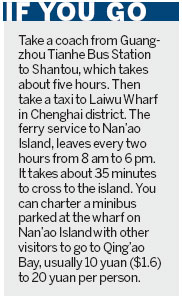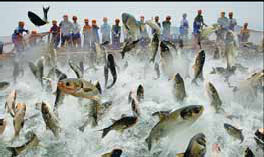Treasured Islands
Updated: 2013-06-12 08:02
(China Daily)
|
||||||||
|
The Catholic church in Shengtang village on Weizhou Island was built using the island's volcanic rocks and coral. Provided to China Daily |
A small, enchanting isle makes the perfect getaway for Dragon Boat Festival, we recommend four of the best.
There's something appealing about the idea of escaping the grind of daily routine by cutting and running to a desert island. The thought of sun, sand and sea appeals to the Jack Sparrow in all of us. Fortunately, you don't have to go far to find a place where your imagination can bring you a distant horizon and you can savor the finest fruits from the sea. For instance, Weizhou Island in the northern part of Beibu Gulf is hailed one of China's most beautiful islands. It not only features fabulous sea views, but also boasts diverse Hakka customs. While Nan'ao Island in Guangdong province is the home to hundreds of tropical and sub-tropical plants. Both Qiandao Lake and Zhoushan guarantee people fresh and tasty sea food.
Primal seaside landscapes shaped by volcano
Guangxi
Xu jingxi in Guangzhou
As China's largest, youngest volcanic island, Weizhou Island to the southeast of Beihai, Guangxi Zhuang autonomous region, is a showroom for nature's craftsmanship.
Once-molten lava frozen by time thousands of years ago has been putty in the hands of the sea, the waves sculpting it into caverns, pillars and terraces and the sinewy shapes of petrified plants and animals.
A 3-meter-tall, 6-meter-wide mushroom stands near Xigang wharf and there are a turtle, seal, manatee and whale, to name just a few of the marine creatures that turn the bay at the south end of the island into a marvelous stone menagerie.
Besides the beautiful scenery onshore, divers can enjoy the underwater kaleidoscope of China's own "Barrier Reef", as the offshore marine areas are perfect cradles for coral.
Shiluokou Beach on the west side of Weizhou is probably the best beach for diving on the island, and nearby is a belt of acropora corals that stretches several kilometers waiting for you to explore.
The undersea volcanic rocks will also delight divers, as colorful fish will play hide-and-seek among the holes in the rocks.
Weizhou Island is also known for its breathtaking sunrises and sunsets.
Sesame Beach, which got its name because it looks like it's covered with shimmering sesame seeds, is the place to go to watch the sunrise.
The best place to appreciate the sunset is Drippy Rock beach, where vegetation cascades down a 10-meter high rock face. A French Catholic church that was built in 1880 with volcanic rocks and coral is also a must-see attraction and it is still in use today.
Visitors are strongly recommended to stay overnight at a family inn, as the hospitable hosts can take you out sea fishing, or show you where to pick up oysters when the tide goes out or how to catch crabs on the beach at night.
Besides seafood, jackfruit and bananas are also tasty and plentiful on the island.
From Weizhou Island you can see Xieyang Island, which is covered with acacias and cactus flowers. It takes about 30 minutes to reach and offers an even quieter experience, as there are no restaurants or hotels.
You can explore the Ox Nose Cave in the north, or stroll down the eastern beach to appreciate the bizarre knots formed by marine abrasion.

xujingxi@chinadaily.com.cn
|
A cycling competition held in Nan'ao attracts nearly 400 people across the country. Ma Ka / for China Daily |
History and modernity
Guangdong
Xu jingxi
What comes to mind when you think of an island holiday? Sunbathing on the beach, fresh seafood, a dip in the sea? Nan'ao Island near Shantou, a beautiful harbor city in the east of Guangdong province, offers all these plus historical relics dating back to the Southern Song Dynasty (1127-1279), plus the largest insular wind farm in Asia.

The country's only surviving zongbing office, a title used during the Ming (1368-1644) and Qing (1644-1911) dynasties for the commanding officer of garrison troops in an area, is located at the center of Shen'ao town on the island. Altogether 173 zongbing and deputy zongbing were sent to the island from 1576-1911 to safeguard Guangdong and Fujian provinces and the island of Taiwan.
Now the office serves as a museum outlining the history of Chinese coastal defenses. Visitors can catch a glimpse of the past by touching two weighty old cannons and reading the 23 stone tablets on customs regulations on the walls.
There are two huge 400-year-old banyans standing in front of the office. A statue of Zheng Chenggong (1624-62), a Ming Dynasty general who led the army that put an end to the Dutch occupation of Taiwan, stands beside one of the trees, where he gave a rousing speech to recruit soldiers.
Cycling is the best way to explore the island. Nan'ao leans on mountains and faces the sea, which makes it pleasant to cycle on the mountain roads amid a cool sea breeze.
As you cycle up Guolao Mountain, you'll see the wind farm. More than 100 60-meter-high windmills stand around the top of the mountain, their giant blades slowly turning.
The wind farm is also a wonderland for astronomy lovers, as you can observe lunar craters and other astronomical delights through the high-powered telescopes in the farm's tourist area.
Rent a bike in Shantou before you board a ferry for Nan'ao Island, for there are few bike rental sites on the island.
After a sweaty cycling trip across the island, nothing is cooler than jumping into the sea. Qing'ao Bay is one of Guangdong's two A-class bathing sites, known for its soft sand and clean water. Camping on the beach and spending a night listening to the waves will make your vacation complete.
|
Fresh fish take the center stage at every meal when visiting Qiandao Lake. Provided to China Daily |
Man-made lake a natural attraction
Zhejiang
Shi Yingying in Shanghai
Qiandao Lake, or Thousand Island Lake, to the west of Hangzhou in Zhejiang province, is actually a man-made reservoir, formed by the construction of a power station in 1959, but as part of what has become China's largest forest park it is now a popular destination all year round.

Take a boat tour and explore the lake's six different scenic areas, including the Southeast Lake District, Central Lake District and Fuxi Stone Forest.
As its name suggests, there are more than a thousand islands dotted around the lake, and a stop one of the islands provides the opportunity to gain a higher vantage point and enjoy views that will stir even the most blase soul.
May to August is the fishing season on Qiandao Lake, and watching the fishermen cast huge nets into the lake and then pull them in little by little, draws involuntary gasps from onlookers as large fish jump like corn hot-popping in a pan as they try and escape. Few do, as the centerpiece of any meal, whether on the tour boat or a restaurant, is fresh fish from the lake cooked in many different ways.
But a word of warning, pay attention to the local etiquette when you eat. Turning over the fish is taboo because that action suggests the overturning of a boat and is considered a bad omen by the fishermen in the area.
Back on shore, Xiushui Jie, or the Silk Road is the cobbled street where vendors sell dried fish and other local delicacies. The street is less crowded than those in the water-towns around Shanghai and the vendors are not as pushy.
Outdoor sports, such as hiking or mountain climbing are popular, and there are a variety of water activities to enjoy including parasailing and boating.
But if it's nightlife you want, you're out of luck. Everywhere is pretty much deserted after 8 pm.
shiyingying@chinadaily.com.cn
|
Outdoor restaurants line the seafront in Shenjiamen offering varieties of marine delicacies. Provided to China Daily |
Fresh off the boats
Zhejiang
Wu Yiyao in Shanghai
If the beauty of seafood lies in its freshness, Shenjiamen, a port in Zhoushan, Zhejiang province, must be one of the best places for seafood in China.
With the largest fishing fleet in China, Shenjiamen boasts a bustling promenade of open-air restaurants that deliver fish from net to dish.

More than 60 restaurants line the promenade presenting a wide range of delectable marine goodies, some of which are unusual items that are unlikely to be found elsewhere.
Fried potherb with dried shrimps makes a crispy starter to savor. Despite its simple look, the dish requires a tasty blend of scallion, ginger and soup-stock, to combine the balanced flavors of surf and turf.
For your next course, you can choose from a spectacular display of ingredients that are simply categorized as crabs, fish or shellfish, many of which only the locals and marine biologists can name.
Crabs in Shenjiamen are usually eaten without any seasoning, so the sweetness of fresh crabmeat can be properly savored.
Stir-fried inkfish with celery also highlights the virtue of simplicity. Inkfish is stir-fried with a handful of celery until the two become juicy, then slightly boiled, with a final touch of salt and a trace of white wine.
At the end of 2011, a competition was organized to find the top 10 dishes from the 67 stalls, the first competition of its kind. The main ingredient of all the dishes had to be seafood and the cooking style had to be different from the grand hotels, which meant it had to be home-style cooking.
Not surprisingly, three of the top 10 dishes featured croaker - brown croaker soup, croaker bone and braised croaker with tofu - as it is one of the most common and versatile ingredients in the local cuisine.
wuyiyao@chinadaily.com.cn
(China Daily USA 06/12/2013 page10)

 Michelle lays roses at site along Berlin Wall
Michelle lays roses at site along Berlin Wall
 Historic space lecture in Tiangong-1 commences
Historic space lecture in Tiangong-1 commences
 'Sopranos' Star James Gandolfini dead at 51
'Sopranos' Star James Gandolfini dead at 51
 UN: Number of refugees hits 18-year high
UN: Number of refugees hits 18-year high
 Slide: Jet exercises from aircraft carrier
Slide: Jet exercises from aircraft carrier
 Talks establish fishery hotline
Talks establish fishery hotline
 Foreign buyers eye Chinese drones
Foreign buyers eye Chinese drones
 UN chief hails China's peacekeepers
UN chief hails China's peacekeepers
Most Viewed
Editor's Picks

|

|

|

|

|

|
Today's Top News
Shenzhou X astronaut gives lecture today
US told to reassess duties on Chinese paper
Chinese seek greater share of satellite market
Russia rejects Obama's nuke cut proposal
US immigration bill sees Senate breakthrough
Brazilian cities revoke fare hikes
Moody's warns on China's local govt debt
Air quality in major cities drops in May
US Weekly

|

|











